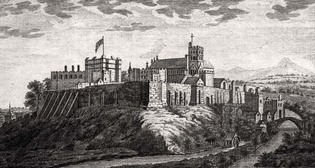History of the Stewarts | Castles and Buildings
If you are a Stewart Society Member please login above to view all of the items in this section. If you want general information on how to research your ancestors and some helpful links - please look in background information.
If you have a specific question you can contact our archivist.

The Jacobite leader Charles Edward Stuart had received intelligence that the British commander General George Wade was advancing with British forces from Newcastle to relieve Carlisle and that he had already arrived in Hexham. Charles Stuart had decided to meet and attack him on hilly grounds between Newcastle and Carlisle. Leaving a sufficient force to blockade Carlisle he departed with the remainder of his army on the morning of 11 November 1745.
Stuart reached Brampton at about ten o´clock and despatched a party of horse led by a Colonel in the direction of Hexham to reconnoitre and ordered his men to take up quarters for the night. The Colonel returned with news that General George Wade´s march to Hexham had been false. Charles waited at Brampton, there is a blue plaque now at the house on the Main Street where he stayed for two days without hearing anything of Wade. A council of war was then held at which several opinions were offered. One opinion was that Charles should march to Newcastle and give battle to Wade. Some of the council thought that this would be a dangerous move, because even if they were to defeat Wade his army might take refuge in Newcastle which would be very difficult to take.
Lord George Murray opposed all of these views and proposed that half of their force should stay at Brampton while the other half besieged Carlisle. The Duke of Perth supported Murray´s opinion and offered to take charge of the force to attack Carlisle if Murray took command of the blockade. The attacking party left the main body of the Jacobite army in Brampton, cutting down wood in Corby and Warwick parks to make scaling ladders and carriages.
On 13 November at about noon, the regiments appointed for the blockade and siege of the city of Carlisle appeared before it. Lord George Murray took up his quarters at Harberyand posted his men in the villages around the city to stop all communication with it. The besieging party broke ground during the evening within musket shot of the city walls. The city´s garrison constantly fired upon the attacking force but as the Jacobites were operating at night they weren´t injured.. The Jacobites soon brought up all of their cannon which consisted of thirteen pieces to attack the town with. The following morning on the 14th the defenders continued their fire with little effect and the Jacobite besiegers, instead of returning fire held up their bonnets on the end of their spades in derision.
Alarmed by the preparations of the Jacobites and the state of affairs within the city a meeting of the inhabitants was held and it was decided to surrender the town. For seven days the inhabitants of the town were kept in constant alarm by the Jacobites´ presence in Brampton followed by the siege. Many of the inhabitants refused to defend the town due to illness and many numbers of them were leaving by slipping over the walls. A white flag was exhibited from the walls and a messenger was despatched to the Duke of Perth to request terms. However, Prince Charles refused to grant any terms to the city unless Carlisle Castle was surrendered as well.
Colonel Durand, the commander of the castle, agreed to surrender the fortress along with the town. The conditions were, that the liberties and properties of the inhabitants, and all the privileges of the town, should be preserved inviolate; - that both garrisons on taking an oath not to serve against the house of Stuart for one year, should be allowed to retire, - and that all the arms and ammunition in the castle and the city, and all the horses belonging to the militia, should be delivered up to the prince. This capitulation was signed by the Duke of Perth and Colonel Durand on the night of 14 November 1745.
The next morning of the 15th, the Duke of Perth, James Drummond entered the city at the head of his regiment and was followed by other regiments at one o´clock in the afternoon. Carlisle Castle however was not given up until the next morning. The Duke of Perth shook hands with the men of the garrison, told them they were brave fellows, and offered them a large bounty to enlist in the service of the prince. The mayor and his attendants went to Brampton, and delivered the keys of the city to the prince.
On the day following the surrender, the Chevalier de St. George was proclaimed in the city with the usual formalities, the mayor and aldermen were compelled to attend with the sword and mace carried before them. The corporation went out to meet the prince, who entered the city under a general salute of artillery..
During the retreat of Charles Edward Stuart´s Jacobites in 1746 he ordered that the Manchester Regiment be left to garrison Carlisle so that he "continued to hold at least one town in England". The Government army under Cumberland then besieged and took Carlisle. Today it still houses The King´s Own Royal Border Regiment.

